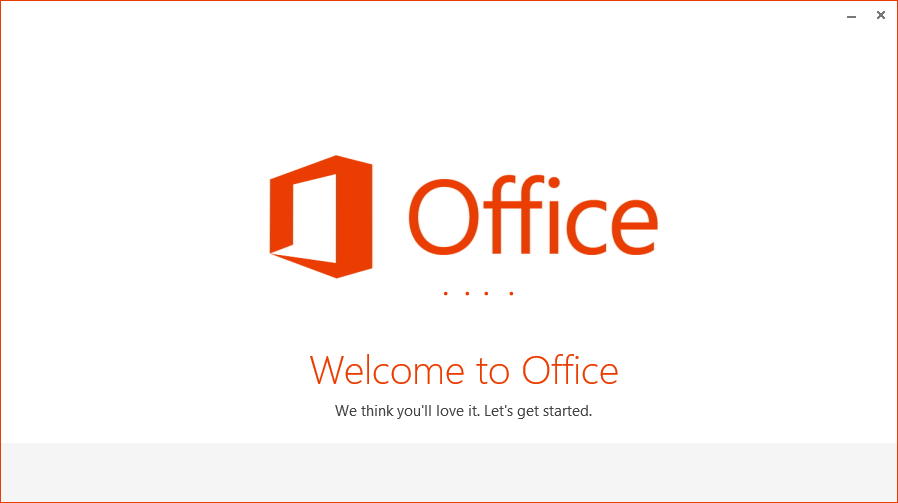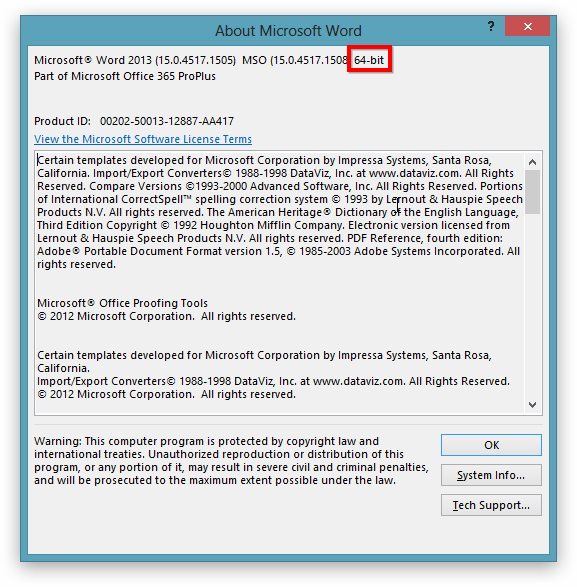How to Choose Between the 32-bit and 64-bit Versions of Office


In the early days of 64-bit versions of Windows, software compatibility issues caused headaches for all but the most experienced users. Software and drivers alike had to be updated to support the 64-bit architecture, and it was widely recommended that users stick to the 32-bit variety of Microsoft’s operating system.
That all changed with Windows 7. Built-in emulation for 32-bit software in a 64-bit environment and widespread driver support made the 64-bit version of Windows a seamless experience for most users. This was important because a 64-bit version of Windows was required to access more than 3 GB of system RAM. As a result, most Windows users on modern PCs now run the 64-bit version of Windows 7 or 8. But there’s still one application you should run in 32-bit mode: Office.
Microsoft Office 2010 and 2013 come in both 32- and 64-bit varieties, and most licenses give users the choice of which one to install. Those still running 32-bit versions of Windows will be limited to 32-bit Office, but 64-bit Windows users may be tempted to choose 64-bit Office. For most users, this is not recommended.
The 64-bit versions of Office 2010 and 2013 do indeed have a potentially important benefit: they allow users to work with extremely large Excel spreadsheets and Project databases. The 32-bit version places hard caps on the size of these items at 2 GB (a total virtual address space which includes the file itself, the application, and any running add-ins). There are no practical limits on file size with the 64-bit version, allowing for enormous spreadsheets and databases. While this is a crucial factor for a very few expert Office users (likely in a large enterprise setting), most users won’t come anywhere near the file size limits imposed by the 32-bit version.

There’s also a slight performance boost to using 64-bit Office on a modern PC running 64-bit Windows, but we really want to stress the slight part of this statement. Most users will not notice the difference in performance between 32- and 64-bit versions of Office on the same PC, and other factors such as the speed of the system drive and the amount of available system memory will both result in a significantly more appreciable performance boost.
But the pros of 64-bit Office may be outweighed by the cons. If you determine that you need the 64-bit version of Office, you’ll need to prepare for a few drawbacks:
- Some features simply aren’t available in the 64-bit version of Office (such as the Word Legacy Equation Editor and Word Add-In Libraries).
- Older VBA code, often crucial for corporate spreadsheets, won’t run in a 64-bit environment unless it has been updated.
- Third party add-ins won’t run unless they have been specifically updated to support the 64-bit version of Office.
- Some Access database files created in the 32-bit version of Office can’t be used with the 64-bit version. They must be recompiled to support the 64-bit version using the original source database (which may not always be available).
- Many add-ins and macros for Outlook won’t work in the 64-bit version.
These limitations of the 64-bit version of Office may cause unpredictable issues for many users, especially those in business environments. Therefore, unless you’re one of the very few users with gigantic Excel and Project files larger than 2 GB, sticking with the 32-bit version of Office will provide a much less frustrating experience with no appreciable difference in performance.
On the other hand, if you plan to run a completely vanilla installation of Office with no add-ins, or if you’ve verified that your required add-ins are 64-bit compatible, you can certainly try the 64-bit version of Office. Just be aware of the compatibility issues if you’re sharing files with other users.
Microsoft expects that 64-bit versions of Office will one day become the norm, just as it did for Windows, but, as of 2013, we’re not there yet.

















2 thoughts on “How to Choose Between the 32-bit and 64-bit Versions of Office”
http://hitech-us.com/articles/entry/11/Windows:-32-Bit-VS-64-Bit-system